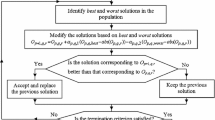Abstract
In this study, two computational approaches, Genetic Algorithm and Simulated Annealing, are applied to search for a set of optimal process parameters value that leads to the minimum value of machining performance. The objectives of the applied techniques are: (1) to estimate the minimum value of the machining performance compared to the machining performance value of the experimental data and regression modeling, (2) to estimate the optimal process parameters values that has to be within the range of the minimum and maximum coded values for process parameters of experimental design that are used for experimental trial and (3) to evaluate the number of iteration generated by the computational approaches that lead to the minimum value of machining performance. Set of the machining process parameters and machining performance considered in this work deal with the real experimental data of the non-conventional machining operation, abrasive waterjet. The results of this study showed that both of the computational approaches managed to estimate the optimal process parameters, leading to the minimum value of machining performance when compared to the result of real experimental data.









Similar content being viewed by others
References
Arizmendi M, Ferna′ndez J, de López Lacalle LN, Lamikiz A, Gil A, Sánchez JA, Campa FJ, Veiga F (2008) Model development for the prediction of surface topography generated by ball-end mills taking into account the tool parallel axis offset. Experimental validation. CIRP Ann Manuf Technol 57(1):101–104
Bandyopadhyay S, Pal SK, Murthy CA (1998) Simulated annealing based pattern classification. Inf Sci 109:165–184
Brezonick M, Kovavic M, Ficko M (2004) Prediction of surface roughness with genetic programming. J Mater Process Technol 157–158:28–36
Caydas U, Hascalik A (2008) A study on surface roughness in abrasive waterjet machining process using artificial neural networks and regression analysis method. J Mater Process Technol 202:574–582
Colak O, Kurbanoglu C, Kayacan MC (2007) Milling surface roughness prediction using evolutionary programming methods. J Mater Des 28:657–666
Cus F, Balic J (2003) Optimization of cutting process by GA approach. Robot Comput Integr Manuf 19:113–121
Jain NK, Jain VK, Deb K (2007) Optimization of process parameters of mechanical type advanced machining processes using genetic algorithms. Int J Mach Tools Manuf 47(6):900–919
Juan H, Yu FS, Lee BY (2003) The optimal cutting-parameter selection of production cost in HSM for SKD61 tool steels. Int J Mach Tools Manuf 43:679–686
Khan Z, Prasad LB, Singh T (1997) Machining condition optimization by genetic algorithms and simulated annealing. Comput Oper Res 24(7):647–657
Kirkpatrick F, Gelatte CD, Vecchi MP (1983) Optimization by simulated annealing. Science 220:671–780
López de Lacalle LN, Lamikiz A, Sánchez JA, Arana JL (2007) The effect of ball burnishing on heat-treated steel and Inconel 718 milled surfaces. Int J Adv Manuf Technol 32(9–10):958–968
Manolas DA, Gialamas TP, Frangopoulos CA, Tsahalis DT (1996) A genetic algorithm for operation optimization of an industrial cogeneration system. Comput Chem Eng 20:1107–1112
Oktem H, Erzurumlu T, Erzincanli F (2006) Prediction of minimum surface roughness in end milling mold parts using neutral network and genetic algorithm. J Mater Des 27:735–744
Oktem H, Erzurumlu T, Kurtaran H (2005) Application of response surface methodology in the optimization of cutting conditions for surface roughness. J Mater Process Technol 170:11–16
Palanisamy P, Rajendaran I, Shanmugasundaram S (2007) Optimization of machining parameters using genetic algorithm and experimental validation for end-milling operations. Int J Adv Manuf Technol 32:644–655
Suresh PVS, Venkateswara P, Deshmukh SG (2002) A genetic algorithmic approach for optimization of surface roughness prediction model. Int J Mach Tools Manuf 42:675–680
Swarnkar R, Tiwari MK (2004) Modeling machine loading problem of FMSs and its solution methodology using a hybrid tabu search and simulated annealing-based heuristic approach. Robot Comput Integr Manuf 20:199–209
Tarng YS, Ma SC, Chung LK (1995) Determination of optimal cutting parameters in wire electrical discharge machining. Int J Mach Tools Manuf 35(12):1693–1701
Wang ZG, Rahman M, Wong YS, Sun J (2005) Optimization of multi-pass milling using parallel genetic algorithm and parallel genetic simulated annealing. Int J Mach Tools Manuf 45:1726–1734
Wong TN, Chan LCF, Lau HCW (2003) Machining process sequencing with fuzzy expert system and genetic algorithms. Eng Comput 19:191–202
Zain AM, Haron H, Sharif S (2010) Application of GA to optimize cutting conditions for minimizing surface roughness in end milling machining process. Expert Syst Appl 37:4650–4659
Zain AM, Haron H, Sharif S (2010) Simulated annealing to estimate the optimal cutting conditions for minimizing surface roughness in end milling Ti-6Al-4V. Mach Sci Technol 14:43–62
Acknowledgments
The authors greatly acknowledge Ministry of Higher Education Malaysia and Universiti Teknologi Malaysia for the financial support. Special thank you to the reviewer for their valuables comments and suggestions.
Author information
Authors and Affiliations
Corresponding author
Rights and permissions
About this article
Cite this article
Zain, A.M., Haron, H. & Sharif, S. Genetic Algorithm and Simulated Annealing to estimate optimal process parameters of the abrasive waterjet machining. Engineering with Computers 27, 251–259 (2011). https://doi.org/10.1007/s00366-010-0195-5
Received:
Accepted:
Published:
Issue Date:
DOI: https://doi.org/10.1007/s00366-010-0195-5




